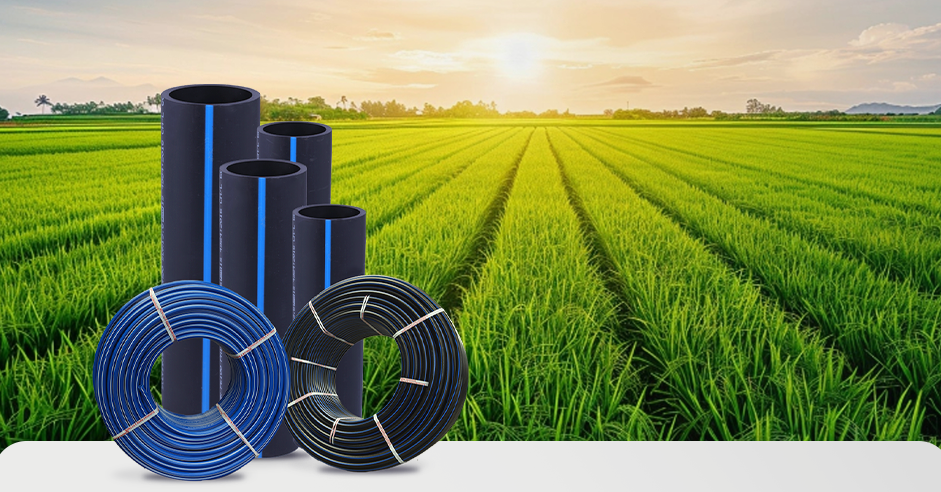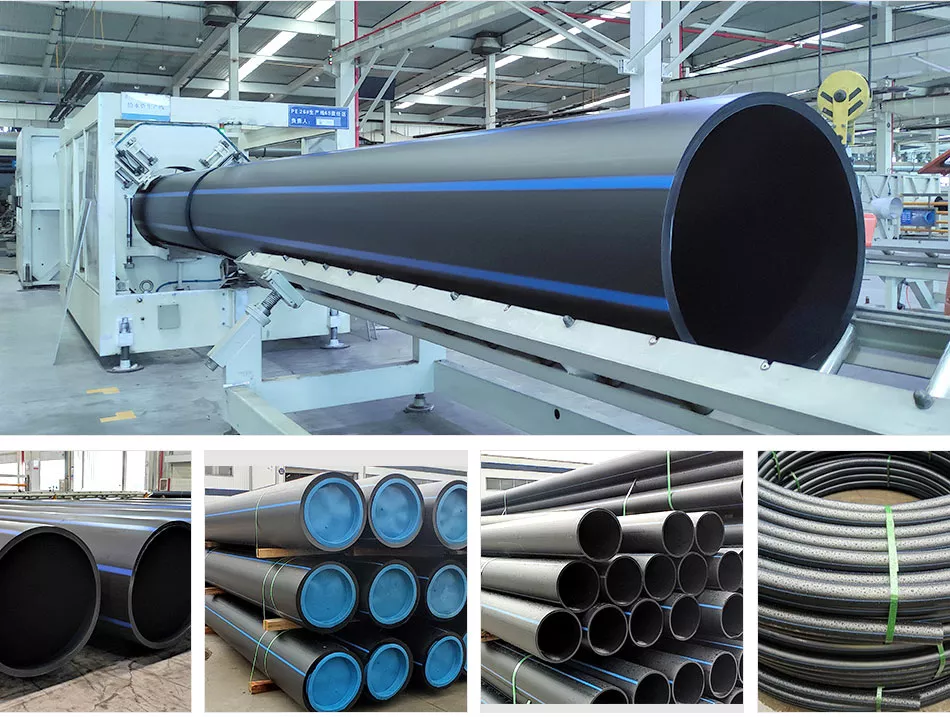The Comprehensive Resource to Pipe Manufacturing Midland TX for Industrial Needs
Discover the Manufacturing Refine Behind High-Quality HDPE Pipe and Its Applications
The manufacturing process of high-quality HDPE pipes is elaborate and systematic. It starts with the choice of resources that enhance efficiency. Following this, ethylene goes through polymerization to form material, which is then shaped via extrusion. Quality control is vital, guaranteeing that the last item satisfies stringent requirements. However, the trip of HDPE pipelines doesn't end with manufacturing. Their applications across different markets reveal a more comprehensive relevance worth examining.
Recognizing HDPE: Properties and Advantages

High-density polyethylene (HDPE) is a flexible thermoplastic recognized for its longevity and resistance to numerous ecological aspects. This product displays excellent tensile stamina, making it ideal for requiring applications. Its low-density framework contributes to a light-weight item, facilitating simplicity of dealing with and setup. HDPE additionally showcases remarkable resistance to chemicals, which lessens deterioration when revealed to rough substances.
The material's reduced dampness absorption further enhances its durability, making it excellent for usage in pipelines and tank. Furthermore, HDPE is resistant to ultraviolet (UV) radiation, making sure that items maintain their integrity also when exposed to sunshine. Its flexibility permits for the creation of complex forms without compromising toughness. The environmentally friendly nature of HDPE, frequently originated from recycled products, contributes to its charm, advertising lasting practices in manufacturing. Generally, these properties and benefits make HDPE a favored selection for numerous commercial and customer applications.
Raw Material Option for HDPE Manufacturing
The choice of raw products for HDPE manufacturing is important to confirm the final item satisfies the wanted requirements and quality criteria. High-density polyethylene (HDPE) is mainly generated from polymerized ethylene, stemmed from fossil gas such as gas or crude oil. The top quality of these feedstocks greatly affects the mechanical and thermal residential or commercial properties of the final HDPE.
Ingredients also play a considerable role in boosting HDPE's efficiency, consisting of anti-oxidants, UV stabilizers, and colorants, which boost sturdiness and resistance to ecological factors. The choice process have to consider not just the chemical structure of the raw products however additionally their processing qualities to ensure effective production.
Additionally, the sourcing of resources must prioritize sustainability and conformity with environmental laws, as accountable methods are important in today's market. Eventually, cautious raw material selection lays the structure for generating premium HDPE pipelines ideal for varied applications.
The Extrusion Refine: Forming HDPE Pipe
The extrusion procedure plays an important function fit HDPE pipelines, beginning with meticulous material preparation techniques that ensure optimal flow and uniformity. Equally vital is the layout of the die, which straight affects the final dimensions and surface area high quality of the pipeline. With each other, these factors contribute significantly to the effectiveness and quality of HDPE pipeline manufacturing.
Product Prep Work Strategies
Reliable production of HDPE pipes starts with thorough product prep work methods, especially the extrusion process. During this stage, high-density polyethylene resin is first dried out to remove dampness, making certain suitable flow features. The material is then fed into the extruder, where it undertakes heating and melting, transforming into a viscous state. This home heating process is very carefully managed to keep the material's honesty and efficiency. The molten HDPE is required with a die, forming it right into a constant pipeline kind. Proper temperature level management during extrusion is essential, as it directly influences the product's residential properties and the last product high quality. Once formed, the HDPE pipe is cooled down and reduced to specified sizes, ready for subsequent handling and applications.
Die Style Value
Precision in die style plays a necessary role in the extrusion process of HDPE pipes. The die works as the final shaping tool, directly affecting the pipe's measurements, wall surface density, and surface area finish. A well-designed die warranties uniform product circulation, lowering problems such as abnormalities and vulnerable points. The geometry of the die should be optimized to suit the particular residential properties of HDPE, including its viscosity and thermal behavior throughout extrusion. Additionally, the cooling rate of the product as it goes through the die can noticeably affect the pipe's structural honesty. Investing in sophisticated die innovation is essential for makers intending to produce top quality HDPE pipelines that fulfill market standards and client expectations.
Quality Control Measures in HDPE Manufacturing
Although different variables affect the quality of HDPE pipeline manufacturing, reliable quality assurance steps are critical to ensure consistency and integrity in the final item. Trick quality control methods include extensive product examination, verifying that the raw polyethylene meets recognized criteria for pureness and thickness. Throughout the extrusion process, criteria such as temperature level, stress, and cooling time are carefully kept track of to keep dimensional precision and structural stability
In addition, post-production screening is essential; producers usually carry out hydrostatic examinations to examine the pipeline's stamina and resistance to stress. Aesthetic examinations for surface flaws further improve top quality assurance. Accreditation from pertinent criteria organizations, like ASTM or ISO, supplies an additional layer of reliability. By implementing these comprehensive top quality control steps, producers can lessen defects, boost performance, and guarantee that the HDPE pipes fulfill the certain demands of numerous applications, inevitably causing client fulfillment and rely on the item.
Applications of HDPE Pipeline Across Industries
HDPE pipes are made use of across numerous markets as a result of their resilience and versatility. In water distribution systems, they guarantee reliable delivery, while in wastewater management, they provide reliable solutions for waste transportation. Furthermore, farming irrigation networks gain from HDPE's resistance to deterioration and adaptability, making it an optimal option for modern farming practices.

Water Distribution Solutions
A significant variety of sectors depend on high-density polyethylene (HDPE) pipelines for efficient water distribution systems. Recognized for their toughness and resistance to rust, HDPE pipelines are extensively used in community water system networks, agricultural watering, and commercial applications. Their lightweight nature helps with simple handling and installment, lowering labor costs and time. Furthermore, HDPE pipelines can accommodate various pressure degrees, making them ideal for both low and high-pressure systems. hdpe pipe fittings Midland TX. The flexibility of the material permits seamless assimilation right into existing facilities, lessening the demand for substantial excavation. Moreover, HDPE's resistance to chemical leaching assurances that the water delivered continues to be risk-free and clean, making it a perfect choice for keeping the high quality of safe and clean water throughout different sectors
Wastewater Administration Solutions
Effective water circulation systems also lead the way for innovative wastewater monitoring options, where high-density polyethylene (HDPE) pipes play a substantial duty. Distinguished for their toughness and resistance to rust, HDPE pipelines are ideal for transporting wastewater in different setups. Their adaptability permits simple installation in intricate atmospheres, reducing the demand for considerable excavation. In addition, HDPE's smooth interior surface decreases rubbing, enhancing circulation rates and performance. These pipelines are additionally immune to chemical leaching, making certain that contaminants do not jeopardize the surrounding environment. Industries, communities, and treatment centers increasingly depend on HDPE pipelines for their reliability and longevity, making them a favored choice for modern-day wastewater management systems. This adaptability underscores the crucial significance of check here HDPE pipes throughout countless applications.
Agricultural Watering Networks
Agricultural watering networks profit substantially from the usage of high-density polyethylene (HDPE) pipelines, which offer effective and dependable water distribution to plants. HDPE pipelines are light-weight, making them easy to carry and install, while their adaptability enables numerous configurations in diverse surfaces. These pipes demonstrate superb resistance to corrosion, chemicals, and UV radiation, ensuring durability in severe farming settings. In addition, their smooth indoor surface area minimizes rubbing loss, optimizing water circulation and minimizing power expenses connected with pumping. The longevity of HDPE pipelines, often exceeding 50 years, adds to reduce maintenance and replacement costs. As a result, farmers progressively count on HDPE pipelines to enhance watering efficiency and advertise sustainable farming practices, eventually resulting in enhanced crop yields and resource conservation.
Future Trends in HDPE Pipe Technology
As the demand for sustainable and reliable facilities grows, advancements in HDPE pipe technology are poised to change numerous markets. Emerging fads consist of the assimilation of smart technologies, such as sensors and IoT capabilities, which facilitate real-time tracking of pipe problems, decreasing maintenance prices and avoiding leaks. Furthermore, the growth of advanced manufacturing strategies, such as 3D printing, is making it possible for the manufacturing of complicated, customized pipe designs that cater to certain job demands.
Moreover, the focus on recycling and circular economic situation techniques is driving the technology of HDPE pipes made from recycled materials, enhancing sustainability. Improved jointing techniques, such as electro-fusion and mechanical installations, are also enhancing installation efficiency and dependability. The growing emphasis on environmental policies is pressing producers to take on greener manufacturing procedures, ensuring that HDPE pipelines not just meet market standards but additionally promote an even more sustainable future for framework growth.
Often Asked Concerns
Just How Does HDPE Contrast to Other Plastic Products?
HDPE outmatches lots of various other plastic materials relating to toughness, chemical resistance, and versatility. Its reduced density and high tensile toughness make it perfect for various applications, often going beyond alternatives in both performance and durability.
What Are the Environmental Influences of HDPE Production?
The environmental impacts of HDPE manufacturing consist of greenhouse gas discharges, power usage, and potential pollution from manufacturing processes. In addition, incorrect disposal can lead to dirt and water contamination, elevating issues concerning long-lasting ecological results.
Can HDPE Pipes Be Reused?
Yes, HDPE pipelines can be recycled. Many centers accept utilized HDPE for handling, changing it into new items. This recycling contributes to sustainability efforts, decreasing plastic waste while conserving sources and energy in the manufacturing cycle.
What Is the Life-span of HDPE Water Lines?

Exactly How Do Temperature Level Variations Affect HDPE Pipe Performance?
Temperature level variants substantially influence HDPE pipe efficiency, influencing adaptability and stamina. Heats can result in softening, while low temperatures may cause brittleness, ultimately affecting the pipeline's durability and suitability for numerous applications in varied environments.